Bennemann K.H., Ketterson J.B. Superconductivity: Volume 1: Conventional and Unconventional Superconductors; Volume 2: Novel Superconductors
Подождите немного. Документ загружается.


1110 P.S. Riseborough,G.M. Schmiedeshoff,and J.L.Smith
This order parameter has a line of nodes in the equa-
torial plane and two isolated point nodes, one at
each of the poles. Hence, the quasi-particle density of
states is linearly proportionalto E at lowenergiesand
is logarithmically divergent at E =
0
.Thethermal
conductivity tensor only has diagonal components
and is isotropic in the x–y plane. The anisotropy of
the tensor is governed by the angular integrals
I
z,z
(E)=
0
2
d sin cos
2
E
0
2
−sin
2
2 ,
I
x,x
(E)=
0
4
d sin sin
2
E
0
2
−sin
2
2 ,
(19.212)
where the integration only runs over the ranges of
wheretheargumentofthesquarerootispositive.
For small E,these integrals are proportional to E
4
/
4
0
and E
2
/
2
0
respectively. The differences in the behav-
ior occurs because, at low energies, the line of nodes
has more weight than the point nodes and the factor
of cos
2
in the z component of the tensor is limited
to be smaller than E
2
/4
2
0
while sin
2
≈ 1. Hence,
for temperatures such that k
B
T 0.2
0
, one ex-
pects that
z,z
(T) ∝ T
3
,while
x,x
(T)=
y,y
(T) ∝ T.
The different temperature dependence of the compo-
nents of the thermal conductivity tensor reflect the
presence of the line of nodes in the equatorial plane.
Any anisotropicbehaviorof (T)isexpectedtobe
extremely difficult to observe experimentally,since a
slight misalignment of the crystal,the presence of do-
mains or grain boundaries, etc., may cause the mea-
sured thermal conductivity to be dominated by the
largest component of the tensor.
Triplet Pairing
Inthecaseoftripletpairing,thequasi-particlecon-
tribution to the thermal conductivity can be written
in a form analogous to the thermal conductivity for
anisotropic singlet pairing. The tensor can be ex-
pressed as
ij
(T)=
2
k
2
F
m
2
k
B
T
2
()
∞
0
dEEsech
2
ˇE
2
(E)I
i,j
(E) ,
(19.213)
where (E) is the scattering time and I
i,j
(E)isgiven
by
I
i,j
(E)=
d§
4
ˆ
k
i
ˆ
k
j
E
2
− |
−→
d (
ˆ
k) |
2
. (19.214)
In the BW phase,the order parameter is nodeless and
so, the thermal conductivity is diagonal, isotropic
and exponentially activated. Thus, the thermal con-
ductivity in the BW phase is similar to the thermal
conductivity of the BCS state.
For the ABM state, the low temperature thermal
conductivity is anisotropic. As the magnitude of the
order parameter varies as |
−→
d (
ˆ
k)| =
0
sin ,the
factor of k
2
i
in the diagonal components of the ther-
mal conductivity tensor introduces an extra factor
of E
2
/
2
0
in the low-temperature limit of the trans-
verse components compared with the longitudinal
component. The longitudinal thermal conductivity
is estimated as
(T)=
2
k
2
F
k
B
T
2
m
2
()
∞
0
dEEsech
2
ˇ E
2
(E)
E
3
|
0
|
2
(19.215)
and the transverse components are estimated as
⊥
(T)=
2
k
2
F
k
B
T
2
m
2
()
∞
0
dEEsech
2
ˇE
2
(E)
E
5
|
0
|
4
.
(19.216)
In the Born approximation, since
ABM
(E)variesas
E
2
and thus (E) ∝ E
−2
, the longitudinal compo-
nent of the thermal varies as
(T) ∝ T whereas the
transverse components vary as
⊥
(T) ∝ T
3
.
For the polar state,where |
−→
d (
ˆ
k)| =
0
cos which
vanishes along the equatorial plane, the transverse
and longitudinal components of the thermal con-
ductivity tensor are given by
⊥
(T)=
2
k
2
F
k
B
T
2
m
2
()
∞
0
dEEsech
2
ˇE
2
(E)
E
2
|
0
|
(19.217)
and

19 Heavy-Fermion Superconductivity 1111
(T)=
2
k
2
F
k
B
T
2
m
2
()
∞
0
dEEsech
2
ˇE
2
(E)
E
4
|
0
|
3
.
(19.218)
In the polar state, the quasi-particle density of states
is given by
p
z
(E) ∝ E,hence(E) ∝ E
−1
.Thus,one
has
(T) ∝ T
3
and
⊥
(T) ∝ T.Itshouldbenoted
that the anisotropy in the T dependence of (T)is
switched between thepolar and theABM states [389].
Since
0
k
B
T, the above results imply that the
linear T term will dominate the experimentally de-
termined temperature variation of the thermal con-
ductivity of either a polar or anABM state.In general,
alinearT dependence is expected for states with ei-
ther point or line nodes. Also, if the Lorentz number
found in the normal state is constant, as is expected if
impurities provide the dominant scattering mecha-
nism, the thermal conductivity in the superconduct-
ing state should have a magnitude which is very sim-
ilar to the normal state value. The above results were
obtained using the Born approximation. However, it
has been argued that, even in the normal state, it is
not valid to treat impurity scattering within the Born
approximation since the impurity scattering may be
resonant, i.e., close to the unitarity limit.
If the impurity scattering is resonant and k
B
T
/2,then in the ABM phase one has (E) ∼
0
,while
(E) ∝ E ln
2
E in the polar phase. Thus, for resonant
scattering,the leading T dependences for the compo-
nents of the thermal conductivity for the ABM phase
are expected to be
(T) ∝ T
3
and
⊥
(T) ∝ T
5
.The
polar phase has the opposite anisotropy to the ABM
phase, however, additional factors of ln
2
T multiply
the leading low-temperature powers of T.Thatis,
for the polar phase,
(T) ∝ T
5
ln
2
T and
⊥
(T) ∝
T
3
ln
2
T.In general,it is expected that for strong scat-
tering by dilute impurities such that the T-matrix
approximation is valid [159,390],the orientationally
averaged thermal conductivity (T) should follow
a T
3
law if the order parameter has point nodes or
should followa T
2
law if the order parameter has line
nodes.
However, the resonant impurity scattering may
be sufficiently large to cause the superconducting
quasi-particle density of states to be finite at zero
energy. In this case, it has been shown [391] that
the low-energy superconductingquasi-particles may
be strongly localized, even when the normal state
quasi-particles are not. This results in a universal
expression for the d.c. limit of the electrical con-
ductivity of the superconducting state which is finite
and independent of the disorder. As a consequence,
for k
B
T /2, a Wiedemann–Franz like relation
holds [392]. This relation shows that, in the very low
temperaturelimit,the superconductor’sthermal con-
ductivity (T)shouldalsobelinearinT,irrespective
of the node structure. Furthermore, the largest com-
ponent of
i,j
(T) can also be independent of impurity
scattering forcertain types of order parameter [392].
These results can be understood by recognizing that
the effect of strong impurity scattering is to random-
ize the Fermi surface, thereby acting to restore its
approximate spherical symmetry.
The electronic contribution to the thermal con-
ductivity of UBe
13
does not follow the exponentially
activated law expected from BCS theory but shows
a T
2
variation in the superconducting state at rel-
atively high temperatures (between 0.8 and 0.1 K)
which could be indicative of lines of nodes in the
order parameter [28]. However, this assignment is
contrary to the assignment of point nodes made on
the basis of the T
3
variation observed in the specific
heat.Experiments on some samples show that,below
100 mK, (T) varies linearly with T
(T)=˛
s
T , (19.219)
where ˛
s
=0.03 mW K
−2
cm
−1
[266]. The temper-
ature dependence of for the two different tem-
perature regimes found in this sample of UBe
13
are
shown in Fig. 19.59. However, other samples do not
show any noticeable linear temperature dependences
[393]. This seems to indicate that the thermal con-
ductivity is extremely sensitive to the quality of the
sample.
The temperature dependence of the thermal con-
ductivity of UPt
3
also does not follow an exponential
activation law but has a temperature variation which
canbefitbythesumofaT and a T
2
term[29,394,395]
(T)=˛
s
T + ˇ
s
T
2
. (19.220)
The value of the coefficient of the linear T term, ˛
s
,
was found to vary from sample to sample, varying
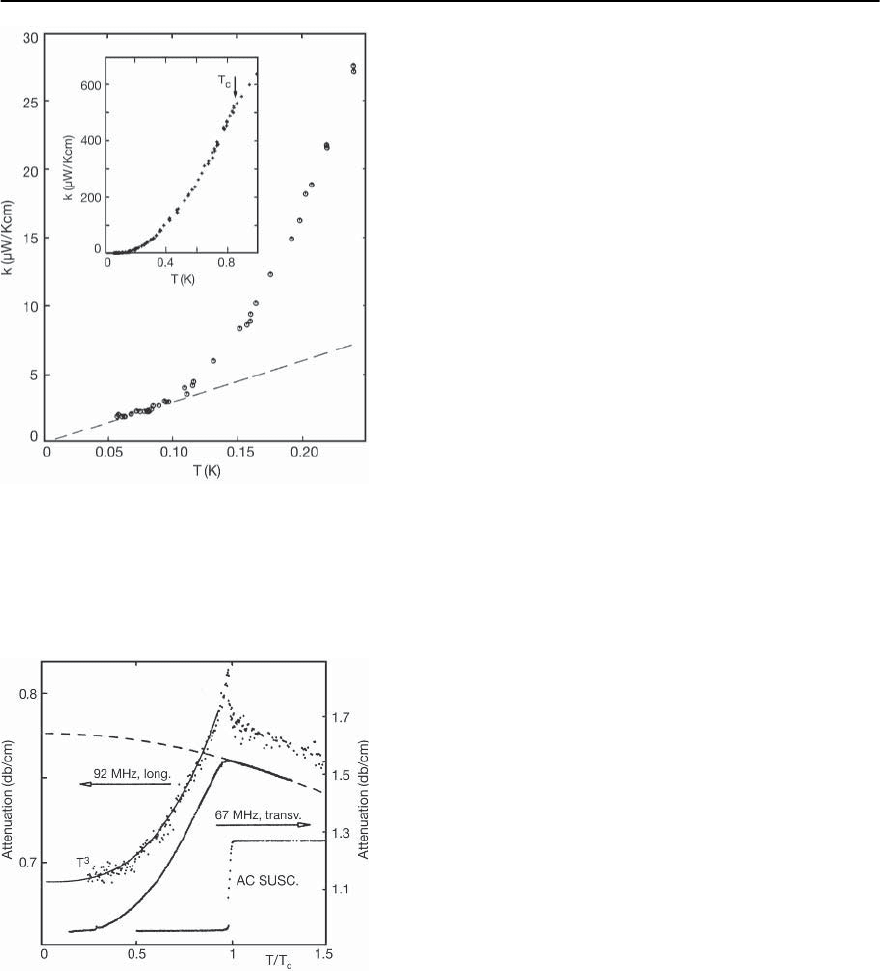
1112 P.S. Riseborough,G.M. Schmiedeshoff,and J.L.Smith
Fig. 19.59.Thetemperature dependenceof thethermal con-
ductivity of UBe
13
, at low temperatures. The dashed line
represents a possible linear term (T)=˛
s
T.Theinset
shows the temperature dependence of in a wider tem-
perature range which extends up to T
c
. [After Ravex et
al.[266]]
Fig. 19.60. The temperature dependence of the attenuation
rate for longitudinal and transverse sound in UPt
3
.[After
M¨uller et. al [402]]
from 0.55 to 12 mW K
−2
cm
−1
.Themagnitudeof
the coefficient ˇ
s
of the T
2
term in UPt
3
can be as
large as 60 mW K
−3
cm
−1
[395] which is two orders
of magnitude greater than the corresponding coef-
ficient in UBe
13
. The strength of the T
2
term in the
(T)ofUPt
3
is also much larger than the correspond-
ing term found from the (T)ofCeCu
2
Si
2
[396],for
which ˇ
s
∼ 1.8mWK
−3
cm
−1
and ˛
s
∼ 0.28 mW
K
−2
cm
−1
.Although ananisotropyof (T) was de-
tected in UPt
3
[397],theanisotropy is fully developed
in the normal state and (T) becomes more isotropic
for temperatures below the second superconducting
transition. An analysis of the measurements favors
an order parameter with a form similar to Y
2
1
(, ')
butdidnotconclusivelyidentifythesymmetryofthe
gap. Figure 19.60 gives results for the attenuation in
UPt
3
.
The lack of agreement with expectations based on
simple quasi-particle theories and elastic impurity
scattering is perhaps not surprising, since the valid-
ity of the quasi-particle description of the normal
state of both UBe
13
and CeCu
2
Si
2
is questionable.
Ultrasonic Attenuation
Measurements of the ultrasonic attenuation should
allow the temperature dependence and the
anisotropy of the gap to be determined. Within BCS
theory,and even with s-wave pairing, the attenuation
coefficients for longitudinal and transverse sound
are different. This difference occurs since a longitu-
dinal sound wave merely produces a time-dependent
scalar potential which acts on the electrons, whereas
a transverse sound wave produces a transverse elec-
tromagnetic field and hence, is subject to the Meiss-
ner effect.The Meissner effect has the effectof reduc-
ing the coupling strength between the electrons and
the transverse phonons and, therefore, reduces the
transverse attenuation rate just below the supercon-
ducting transition[398,399].This mechanism is held
to be responsible for an almost discontinuous drop
in the attenuation rate for shear waves in Al [400]
and In [401] at T
c
. Below the transition tempera-
ture, the evolution of the superconducting gap leads
to a further reduction of the attenuation rate. This
behavior is in direct contrast with the ultrasonic
attenuation of the heavy-fermion superconductors
UPt
3
[44, 402–404], UBe
13
[26] and URu
2
Si
2
[405],
where peaks have been found in the ultrasonic atten-
uation just below T
c
.
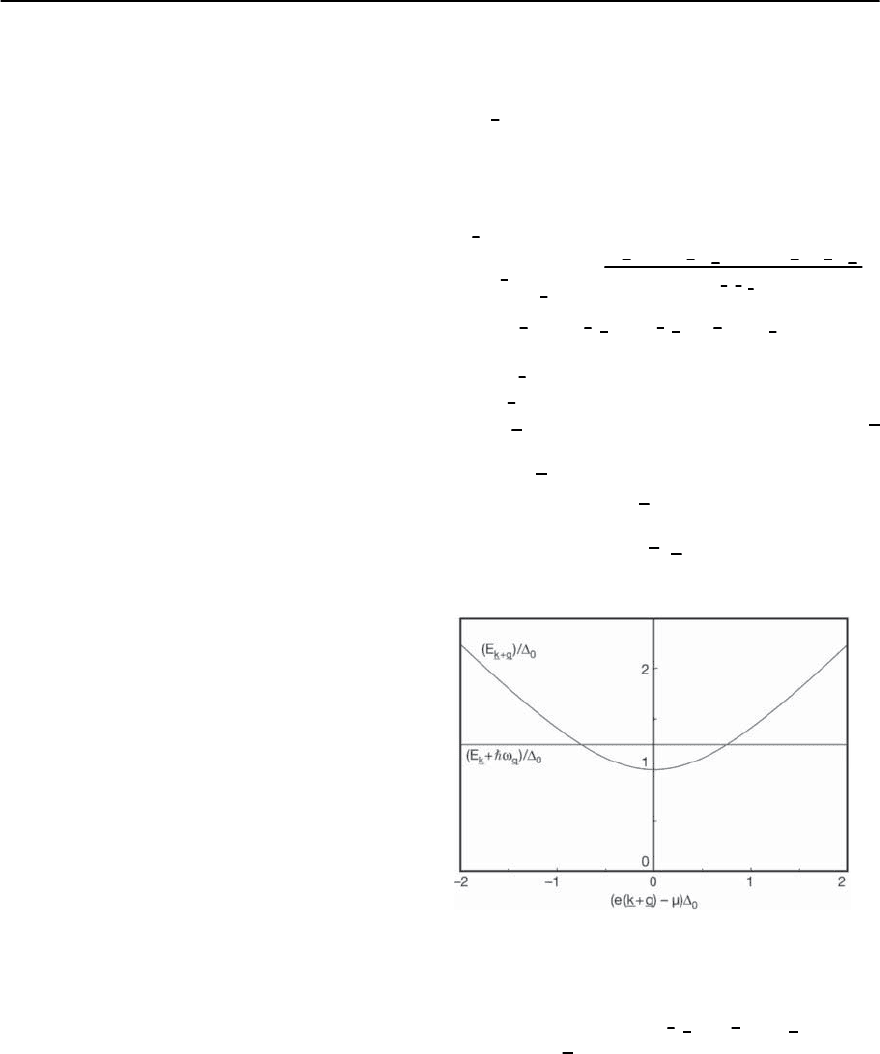
19 Heavy-Fermion Superconductivity 1113
A sharp peak in the longitudinal attenuation coef-
ficient was observed in UBe
13
in the form of a -like
anomaly at a temperature just below the supercon-
ducting transition temperature of 0.8 K [26]. A simi-
lar sharp -likepeak forthe attenuation of longitudi-
nal sound waves in UPt
3
was found at a temperature
of about 500 mK [402]. A less pronounced and more
rounded peak was also seen in the attenuation of
transverse sound waves in UPt
3
[403,404].The peak
in URu
2
Si
2
[405] is of the form of a rounded -like
anomaly and has a maximum at a temperature of ∼
1.25 K, which is below the superconducting transi-
tion T
c
of 1.35 K. Initially, ithad been speculated that
these peaks have their origin in the collective modes
of the superconducting order parameter, similar to
the collective modes observed in
3
He. However, in
this case, the analogy with
3
He is flawed. Since the
crystals do not posses continuous rotational symme-
tries, but only have the discrete rotational symme-
tries contained in their point groups, the collective
excitations are not Goldstone modes. If spin-orbit
scattering is strong in these U compounds, the fre-
quencies of the collective modes of the order param-
eter could have magnitudes similar to the supercon-
ducting gaps. Furthermore, these collective modes
are only expected to be well defined [132,406]at very
low temperatures in very clean materials. Since the
peaks in the attenuation coefficient occur at tem-
peratures just below the critical temperatures, and
since there appears to be a residual zero energy den-
sity of states due to impurity scattering, the collec-
tive modes are expected to be overdamped, there-
fore, this explanation seems unlikely. An alternate
viewpoint was provided by Coffey [407],who related
the peak in the attenuation to the enhanced quasi-
particle masses which makes the velocity of sound
comparable to the Fermi velocity. In this picture, the
conductivity enters the expression for the longitudi-
nal attenuation rate,thereby producing a screening of
the electron–phonon coupling.As in the normal state
conductivity, the mass enhancement factor produces
a sharp low-frequencyDrude peak in the conductiv-
ity. Although this effect is also predicted for a BCS
state, it is stronger in anisotropic superconducting
states where the low-energy quasi-particle density of
states is finite, and so,the screening is more effective.
Low Temperatures
As a precursor to the discussion of the anisotropy
in ˛
q
(T), we shall first examine the ultrasonic at-
tenuationinanordinarysingletsuperconductor.For
a singlet superconductor, the attenuation rate is ap-
proximated by the Fermi Golden Rule expression
˛
q, ˆ
=
2|
q, ˆ
|
2
k,
1+
(e(k
)−)(e(k + q)−)−D(k) D(k + q)
E
k
E
k+q
× ( f (E
k
)−f (E
k+q
))ı( E
k+q
− E
k
− !
q, ˆ
) , (19.221)
where
q, ˆ
is the electron–phonon coupling strength,
and !
q, ˆ
is the frequency of a phonon with wave-
vector q
and polarization
ˆ
. The summation over k
can be separated into an integral over the magnitude
of k (or e(k
)) and an integral over the polar angle, ,
defined with respect to q
.Forans-wavesuperconduc-
tor,the angular integral can be replacedby an integral
over themagnitudeof e(k
+q) wherethe rangeof inte-
gration runs between e(k −q)ande(k +q).The range
of this transformed integral is shown in Fig. 19.61.
Fig. 19.61. The range of the integration over energy in
Eq. (19.222), representing the integration over the polar
angle
Conservation of energy E
k+q
= E
k
+ !
q
demands
that the only k
values that contribute to the attenua-
tion are those which are close to the equatorial plane
of the Fermi surface, if v
F
> c and k
F
> q,asshown
in Fig. 19.62. Since the term in the coherence factor
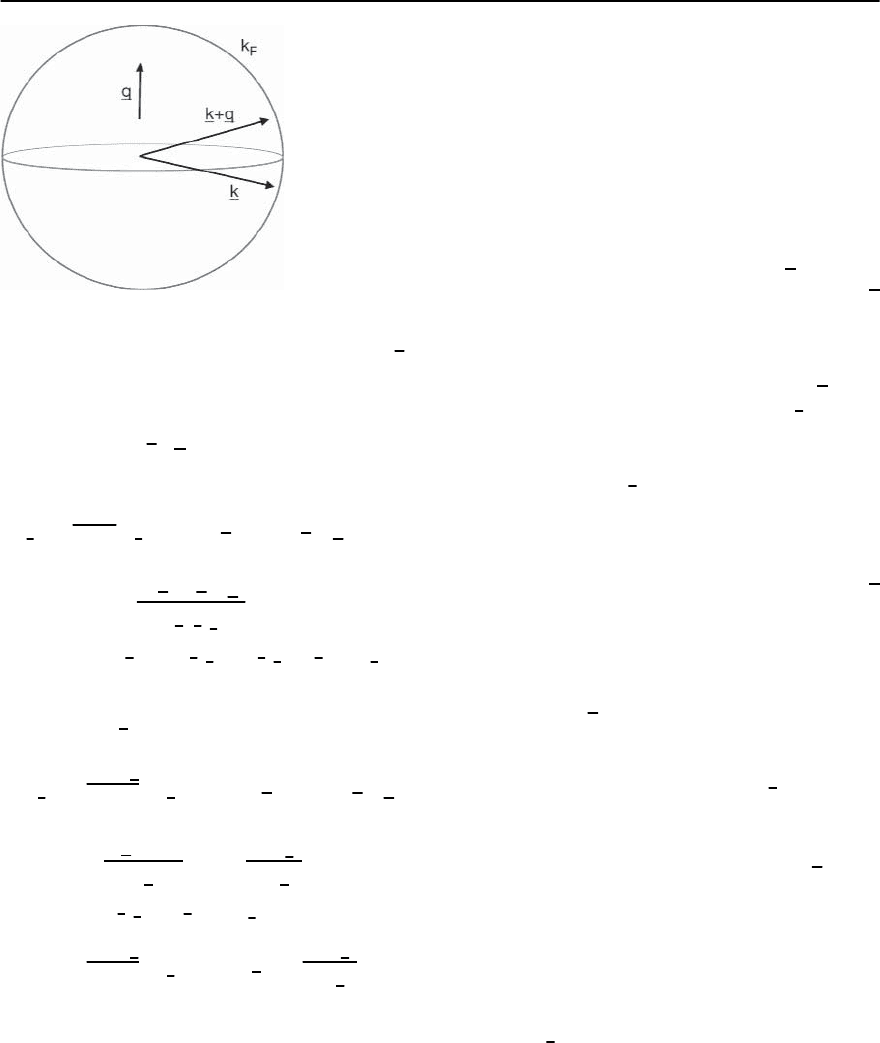
1114 P.S. Riseborough,G.M. Schmiedeshoff,and J.L.Smith
Fig. 19.62. Typical reciprocal space geometry of electrons
involved in the attenuation of sound with wave vector q
,in
the clean limit. The electrons which are primarily involved
in the attenuation process are located near the equator of
the Fermi surface
proportional to e(k +q)− is anti-symmetric under
the integration, it vanishes, thereby yielding
˛
q, ˆ
=
m
2
q
4
|
q, ˆ
|
2
∞
0
de(k)
e(k+q)
e(k−q)
de(k + q)
×
1−
D(k
)D(k + q)
E
k
E
k+q
× (f (E
k
)−f (E
k+q
))ı(E
k+q
− E
k
− !
q, ˆ
) ,
(19.222)
which, since !
q
is small, simplifies to
˛
q,ˆ
=
m
2
!
q
q
4
|
q, ˆ
|
2
∞
0
de(k)
e(k+q)
e(k−q)
de(k + q)
×
e(k
)−
E
k
2
−
∂f (E
k
)
∂E
k
× ı( E
k+q
− E
k
− !
q, ˆ
)
=
m
2
!
q
q
4
|
q, ˆ
|
2
∞
0
dE
k
−
∂f (E
k
)
∂E
k
.
(19.223)
In this expression, the coherence factors have can-
celed with the quasi-particle density of states. Thus,
in a BCS superconductor, the attenuation coefficient
˛(T) should follow the law
˛(T) ∝ f (
0
(T)) , (19.224)
where f (x)istheFermifunctionand
0
(T)isthesu-
perconducting gap. Thus, for temperature far below
T
c
, the attenuation coefficient should be thermally
activated
˛(T) ∼ exp
− ˇ
0
. (19.225)
The above derivation emphasizes that, if q
is defined
as the polar axis, it is the electrons which have k
vectors near the equatorial plane of the spherical
Fermi surface that provide the dominant contribu-
tion to the attenuation of sound waves.Furthermore,
since the contribution from this region of k
space
is weighted by a function depending on E
k
/k
B
T,the
presence of nodes of the order parameter within this
equatorial plane may result in a power law tempera-
ture dependence of ˛
q
(T).
To illustrate the origin of the anisotropy, con-
sider the clean limit of a polar-like superconductor
with a line of nodes in the equatorial plane of the
Fermi surface [408]. When the propagation vector q
is aligned precisely along the polar axis
−→
d , the atten-
uation process primarily involves excitations on the
line of nodes and, therefore, the attenuation coeffi-
cient resembles that of the normal state. However, if
the direction of q
is slightly rotated, the attenuation
will only involve the low energy excitations near two
isolated points on the line of nodes. Hence, one ex-
pects that the attenuation coefficient ˛
q
(T)willvary
linearly with T. The coefficient of the linear T term
will depend sensitively on the angle (
−→
d . ˆq). For an
ABM-like state, one may expect that if the q
vector
is oriented in a plane exactly perpendicular to the
direction of
−→
d , the low-energy excitations will pre-
dominately be near the isolated point nodes. In this
case, one expects that in this case, the attenuation
coefficient should vary linearly with T.For other ori-
entations the density of low energy excitations is re-
duced, so ˛
q
(T) is expected to be proportional to T
2
.
Most of the heavy-fermion superconducting ma-
terials are not in the clean limit, with the excep-
tionsof UPt
3
and CeCoIn
5
.However,similar types of
anisotropic results and pseudo-selection rules have

19 Heavy-Fermion Superconductivity 1115
been obtained for systems with resonant impurity
scatteringandhigh concentrations[159,409,410].For
example, in the dirty limit, the attenuation of trans-
verse sound waves [411] is proportional to
˛
q, ˆ
(!) ∝ !
2
k
−
∂f
∂E
k
k
(E)
(k
)
E
k
2
ˆ
k.ˆq
2
ˆ
k.
ˆ
2
,
(19.226)
where (k
) ≡ e(k)−. For a superconductor with
a line of nodes and at low temperatures, the largest
contribution comes from k
values close to the nodes.
Due to the geometric factors, the attenuation is small
if either the propagation vector q
or the polariza-
tion
ˆ
is directed towards the nodes and is larger for
other orientations. Hence, even in the dirty limit, the
anisotropy can be used to determine the positions of
the nodes in the superconductors order parameter.
In the heavy-fermion superconductors UBe
13
and
UPt
3
, the low temperature attenuation coefficients
have power law temperature dependences, suggest-
ing that the gaps are anisotropic and have nodes.The
exponent of the power law temperature-dependence
not only varies with the direction of propagation
but also depends upon the polarization of the sound
waves.
For the hexagonal compound UPt
3
,M¨uller et al.
[402] measured the attenuation coefficient for both
longitudinal andtransverse soundpropagating along
the c-axis. At temperatures sufficiently below T
c
,
the transverse [402] and longitudinal waves [27,30]
seemed to show a T
2
dependence of the attenuation
rate. However, a fit to the attenuation of longitudi-
nal sound over a wider temperature range, yields a
T
3
dependence [402]. The attenuation of transverse
sound waves propagating in the basal plane is depen-
dent upon the direction of the polarization. Trans-
verse sound waves propagating in the basal plane but
with polarizations also in the basal plane, showed an
attenuation which is linear in T [403]. This is in di-
rectcontrast with theattenuation of transverse waves
propagating in the basal plane, but with the polar-
ization along the c-axis, which have an attenuation
coefficient that shows a T
2
or T
3
[404] temperature
dependence.Since the polarization dependence van-
ishes in the normal state, this is strong evidence that
the anisotropy is a feature of the superconducting
state. However, the nature of the order parameter is
not easily discerned from these experiments. For a
polar-like state with lines of nodes, the longitudinal
attenuation should have a quasi-linear T dependence
or,for an ABM-like state with point nodes,the atten-
uation should vary as T
2
[159,409]. The experimen-
tal observations of the longitudinal attenuation rate,
therefore, favor an interpretation based on ABM-
like states [408, 412] and rule out polar-like states.
However, the T dependences found in the transverse
sound wave experiments of Shivaram et al. [403] do
not fit the predictionsforABM-like states with point
nodes but instead fit the theoretical results for polar-
like states with lines of nodes.
For UBe
13
,measurements below 0.9 K [26] showed
that the attenuation of longitudinal sound waves fol-
lowed a T
2
variation which implies the existence of
an ABM-like state with point nodes.
Electromagnetic Response
The electromagnetic absorption spectra of an s-wave
superconductor has been calculated by Mattis and
Bardeen [413], using the Kubo formulae.On assum-
ing non-conservation of momentum, either caused
bythepresenceofimpuritiesorbythesamplessur-
face, the absorption spectrum is given by the integral
s
n
=
∞
−∞
dE
BCS
(E)
BCS
(E − !) (19.227)
×
f (E − !)−f (E)
!
1+
2
0
E(E − !)
for ! > 2
0
.AtT = 0, the absorption is evaluated
in terms of the complete elliptical integral functions
E(x)andK(x)as
s
n
=
1+
2
0
!
E
! −2
0
! +2
0
−
4
0
!
K
! −2
0
! +2
0
(19.228)
for ! > 2
0
.AtT = 0 where no thermally excited
quasi-particles are present, the optical conductivity
is zero for frequencies in the range 2
0
> ! > 0.
At higher frequencies,the incident photon can be ab-
sorbed through a process in which a Cooper pair is
broken and two quasi-particles are created.Since the
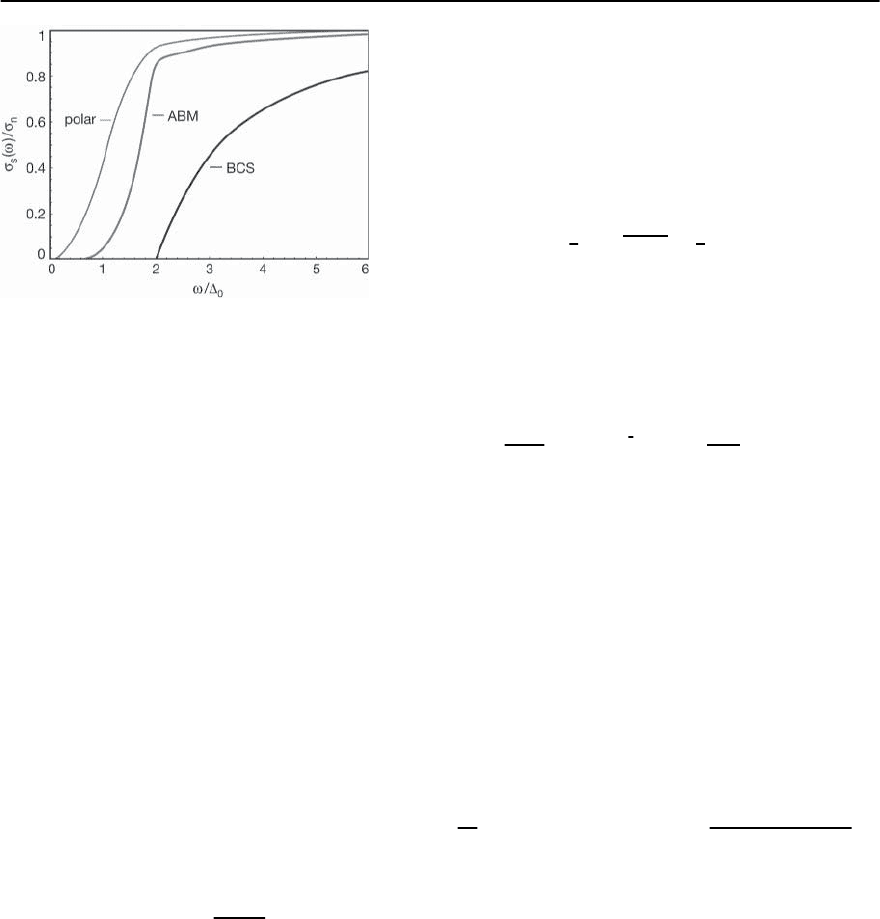
1116 P.S. Riseborough,G.M. Schmiedeshoff,and J.L.Smith
Fig. 19.63. The frequency dependence of the real part of the
T = 0 optical conductivity calculated for various super-
conducting phases. The BCS phase conductivity exhibits a
threshold at ! =2
0
. The ABM and polar phases have
nodes in the order parameter,therefore, the respective con-
ductivities should show power law variations at low fre-
quencies
coherence factors are reduced near the gap edge, the
a.c. conductivity shows a continuous increase above
the threshold frequency and approaches the normal
state conductivity at frequencies much greater than
the gap frequency. Thus, as seen in Fig. 19.63, the
area under the theoretically predicted curve
s
(!)is
smaller than found in the normal state. The ! vari-
ation of (!) calculated by Mattis and Bardeen is
in agreement with experiments on In [414]. There
is also good agreement between the theoretical and
experimentally observed temperature dependence of
(!) for example, as found from measurements of
the microwave surface impedance of Zn [415].
As shown by Tinkham and Ferrell [416], the in-
equality
s
(!) <
n
(!), which is valid for all finite
frequencies,has the consequence that the optical sum
rule
∞
0
d!(!)=
ne
2
2 m
(19.229)
is not satisfied, if the integration is performed down
to a finite cut off at the lower limit. Hence, the con-
ductivity must have a zero frequency delta function
spike in order to satisfy the optical sum rule. This
spike represents the absorption of energy from d.c.
electric fields which produce accelerated supercur-
rents.This spike is of special significanceas causality
connects the ı(!) contribution to the real part of
the conductivity to a 1/! variation in the imaginary
partoftheconductivity.Theexistenceofthe1/!
term shows that supercurrent will flow in response to
a uniform d.c. vector potential
−→
A , thereby screening
the external magnetic field. The ensuing non-local
relation is similar to the (local) London relation
−→
J (r
)=−
c
4
2
L
−→
A (r
) , (19.230)
which involves the London penetration depth
L
.
Within the BCS theory, the penetration depth (T)
should have a leading exponential low temperature
variation [417]. The calculated temperature depen-
dence of the penetration depth is given by
(T)
(0)
−1∝ T
−
1
2
exp
−
0
k
B
T
, (19.231)
since the Fermi surface is completely gapped in s-
wave superconductors.
For anisotropic superconductors which have
nodes in the order parameter, one expects very dif-
ferent results. First, since the angular average of the
order parameter vanishes,and since the tensorial na-
ture of the conductivity has been ignored,the coher-
ence factors are reduced to unity. Hence, the expres-
sion analogous to that of Mattis and Bardeen for the
dirty limit of the absorption spectrum is just given
by the convolution of the quasi-particle density of
states
s
n
=
!
0
dE
qp
(E)
qp
(E − !)
f (E − !)−f (E)
!
.
(19.232)
Second, due to the existence of nodes, the quasi-
particle density of states is finite and, therefore, the
conductivity is expected to be finite down to zero
frequency. For an order parameter with point nodes,
oneexpects thatthe above expression for the conduc-
tivity should vary as !
4
at low frequencies while for
an order parameter with line nodes, one expects an
!
2
variation. The electromagnetic absorption spec-
tra for the BCS, ABM and polar states are shown in
Fig. 19.63. For a more general description of elec-
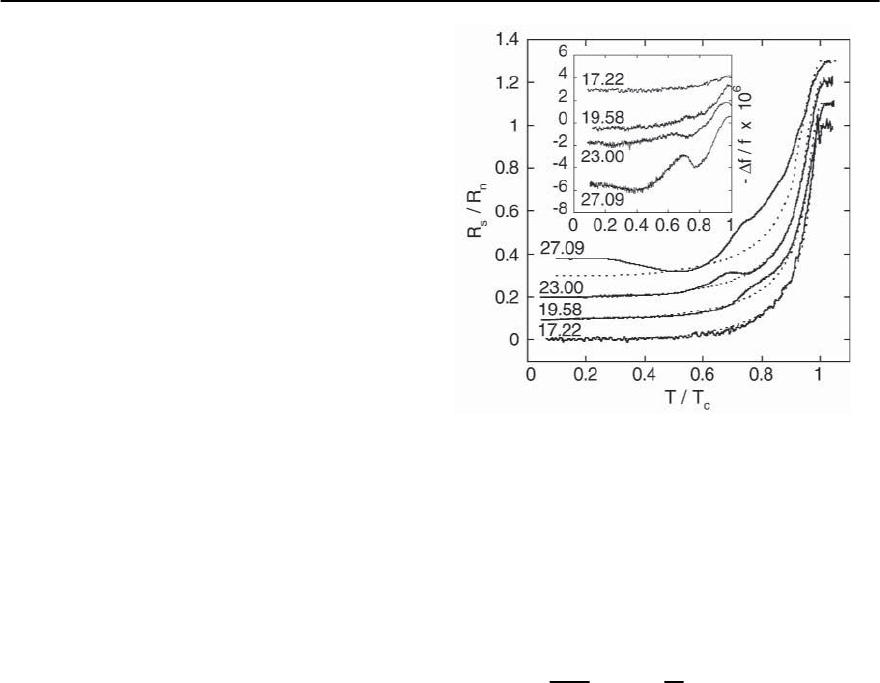
19 Heavy-Fermion Superconductivity 1117
tromagnetic absorption, incorporating the tensorial
nature of the conductivity and the effects of impu-
rity scattering,the interested reader is referred to the
article of Hirschfeld et al. [418]. From an analysis of
this type, Lee [391] found the surprising result that
the ! → 0 limit of the conductivity has a value
which is universal and independent of the impurity
scattering rate. However, if the impurity scattering
is sufficiently strong, Lee [391] has shown that the
electronic states in the superconducting phase may
be localized even though the electronic states in the
normal state are not. The increased tendency for lo-
calization of the superconducting electrons is caused
by the reduction of the effective dimension of the
space in which the quasi-particles close to the nodes
arefreetomove.Thelocalizationleadstothea.c.con-
ductivity being dominated by the thermal activation
of quasi-particle excitations across the mobility gap,
despite any power law energy variation of the quasi-
particle density of states near the Fermi energy.
The temperature dependence of the surface-
impedance of UBe
13
has been measured [419], and
compared with theoretical predictions based on the
BCS state.The value of
0
/k
B
T
c
was treated as an ad-
justable parameter. The experimentally determined
surface-reactance shows a coherence peak just below
T
c
, which is well reproduced by Mattis–Bardeen the-
ory [413], and less well so by the theory of Skalski et
al.[420] which incorporatesthe effect ofa finitespin-
flip scattering rate caused by magnetic impurities.
However, a single value of
0
/k
B
T
c
does not fit the
data at all frequencies, which indicates that the order
parameter corresponds to l =0.Infact,subsequently
anomalous structure (shown in Fig. 19.64) was iden-
tified [421] in the surface-resistance of UBe
13
below
0.8 T
c
, which was attributed to collective excitations
of an l = 0 superconducting order parameter.
Since, as seen in Fig. 19.63, the spectral weight
below twice the maximal gap 2
0
is diminished be-
low thenormalstateconductivity,the zero-frequency
delta functionpresentin
s
(!)isalsoexpectedtoex-
ist in the anisotropic superconducting phases, albeit
with reduced weight. On employing the Kramers–
Kronig relations, one can infer that the penetration
depth should have a power law temperature depen-
dence of the form
Fig. 19.64. The temperature dependence of the surface re-
sistance of UBe
13
, for various frequencies. The surface re-
sistance was normalized to unity at T
c
and zero at T =0.
Each curve is labelled by the measurement frequency in
GHz. Anomalous structures are seen for temperatures in
the interval T
c
> T > 0.8T
c
.Thedotted lines are fits to
the Mattis–Bardeen theory for an s-wave superconductor.
The inset shows the resonant frequency shift. [After Feller
et al. [421]]
(T)
(0)
−1∝
T
T
c
n
, (19.233)
where the exponent n depends on the node struc-
ture of the superconducting order parameter. Power
law temperature variations of the penetration depth
have been observed in heavy-fermion superconduc-
tors for example, a T
2
power law dependence has
been observed in UBe
13
[422]. By contrast, in UPt
3
the superfluid density measured by SR experiments
[423,424] was also found to have a power law tem-
perature dependence but one in which the exponent
is anisotropic.Sincethe main contributionto the su-
perfluid density is governed by the nodes in the su-
perconducting order parameter, the magnetic field
dependence of the penetration depth can be signif-
icant. Yip and Sauls [425] have suggested that this
non-linear Meissner effect might be used to probe
the momentum space positions of the nodes in the
order parameter. However, Li et al. [426] find that in

1118 P.S. Riseborough,G.M. Schmiedeshoff,and J.L.Smith
general, the non-local nature of the electromagnetic
response does mask any non-linear Meissner effect,
except under special circumstances.
Tunneling Measurements
Measurements of quasi-particle tunneling at suffi-
ciently low temperatures are expected to yield the
quasi-particle density of states
qp
(E). We assume
that the tunneling occurs between a normal metal
with a relatively featureless density of state
N
(E) ∼
() and a superconductor, and that the tunneling
matrix element T is independent of k
.Ifabiasvolt-
age V is applied across the junction, the tunneling
current I is given by
I =
2
e|T|
2
∞
−∞
dE
N
(E − eV)
qp
(E)
×
f (E − eV)−f (E)
. (19.234)
The coherence factorsdo not enter the above expres-
sion [427], since the quasi-particle wave functions
are reduced to the normal state wave functions in the
barrier region. Hence, if the differential conductance
is defined by
=
dI
dV
, (19.235)
the differential tunneling conductance is evaluated
as
(V)=
2
e
2
|T|
2
()
∞
−∞
dE
qp
(E)
−
∂f
∂E
E−eV
.
(19.236)
At sufficiently low temperatures, the expression for
the tunneling conductance reduces to
(V) ∝
qp
(eV) . (19.237)
Hence, a measurement of the voltage dependence
of the quasi-particle tunneling conductance should
yield the quasi-particle density of states [428]. Like-
wise, a similar analysis of quasi-particle tunneling
between two superconductors should yield the joint
density of states with features at the sum and differ-
ence of the characteristic energies of the supercon-
ducting density of states for the two materials. For
two s-wave superconductors at finite temperatures,
a discontinuity occurs in the tunneling current for
avoltageV
+
corresponding to the sum of the two
superconducting gaps, while a weak temperature de-
pendent logarithmic singularity occurs in the cur-
rent at the voltage V
−
corresponding to the difference
of the gaps [428,429]
eV
+
=
1
+
2
,
eV
−
= |
1
−
2
| . (19.238)
The observation of the quasi-particle density of
states and, therefore, the characteristic van–Hove
singularities and the low-energy variation, should
provide information about the nature of the order
parameter.However,it should be noted that the pres-
ence of the surface may locally distort the supercon-
ducting phase [430]. In this case, the tunneling ma-
trix elements may become orientational dependent
and the local density of states may differ from the
bulk quasi-particle density of states.
The best tunneling measurements obtained to
date are those on UPd
2
Al
3
. The junctions consisted
of high quality UPd
2
Al
3
films which were separated
from the strong coupling superconductor Pb by a
thin layer of Al [431]. A small magnetic field was
applied in order to suppress the superconductivity
of Pb. For temperatures below the superconducting
transition ofUPd
2
Al
3
,the tunneling conductance de-
veloped a minimum at zero bias voltages and a large
peak structure at a voltage of the order of 0.24 mV.
The large peak structure resembles the van Hove
singularities often found in superconducting quasi-
particle density of states at
0
(see Figs. 19.23 and
19.24). On identifying this voltage with the gap en-
ergy, one finds that the universal ratio
0
(0)/k
B
T is
of the order of 3.71 [432]. The differential conduc-
tance also showed a fainter peak at a voltage of 1.25
mV, which was attributed to strong coupling correc-
tions. These features in the density of states are as-
sumed to originatefromcouplingto unusual antifer-
romagnetic spin excitations seen in inelastic neutron
scattering experiments [348,433].Bycontrast,the in-
terpretation of tunneling experiments on CeCu
2
Si
2

19 Heavy-Fermion Superconductivity 1119
is not so clear cut. The tunnel junctions were con-
structed from CeCu
2
Si
2
which were separated by a
thin oxide layer from an overlayer of Pb. The mea-
surements showed that, for temperatures below the
T
c
of CeCu
2
Si
2
,the tunneling conductance resembles
the superconducting density of states of Pb but is
superimposed with very small features that were at-
tributed to a gapless superconducting quasi-particle
density of states of CeCu
2
Si
2
[434].
Point Contact Spectroscopy
The difficulty of fabricating good tunnel junctions
and the small tunneling probabilitiesassociated with
oxide layers has hampered tunneling experiments.
On the other hand, measurements of the differen-
tial conductance of point-contacts between a super-
conductor and metal are expected to produce larger
currents. In this case, the Cooper pair wave func-
tion of the superconductor extends into the metal
and Andreev reflection may occur [435] along with
the usual single-particle transfer process. That is, an
electron of momentum k
incident on the boundary
between the metal and superconductor may combine
with a normal state electron of momentum −k
to
form a Cooper pair that subsequently resides within
the superconducting condensate.This process can be
viewed as an incident electron, with energy E <
0
,
inside the metal being scattered from the surface of
the superconductor and emerging in the metal as a
reflected hole, thereby transferring a net charge of
2e across the junction. The role of Andreev reflec-
tion in point contact spectroscopy on conventional
s-wave superconductors was pointed out by Blon-
der et al. [436]. Since the conductance depends on
an interface potential which in part models the de-
cay of the pairing potential in the normal metal, the
conductance smoothly evolves between the result for
classic tunneling expressed by Eq. (19.236) and the
extreme Andreev limit.In the extreme Andreev limit,
the conductance of an s-wave superconductor–metal
contact shows a zero biaspeak which is twiceas great
as the normal state conductance of the junction. The
magnitude of the peak height of the normalized con-
ductance is two since a charge of 2e is transferred
across the junction for each normal-metal electron
with energy E <
0
that falls incident on the surface.
Theconductance recoversto thenormalstatevalue at
higher voltages (eV >
0
) as other electron trans-
fer processes gradually take over. Bruder extended
the analysis of Andreev reflection to the case of un-
conventional superconductors [437] and found that
the energy of the peak is extremely dependent on
the type of superconducting order parameter and
the direction of the incident electron’s momentum.
In the usual geometry of point contact measurement,
the electrons have varying angles of incidence with
the boundary and, therefore, conductance measure-
ments yield weighted orientational averages of func-
tions of the order parameter.
Early Point contact tunnelling measurements
were made on UPt
3
and UBe
13
and various metals
[438,439] but did not lead to reliable estimates of the
gaps for the heavy-fermion superconductors. Later,
measurements on UPt
3
[440–442] showed that dis-
tinct minima in the differential conductance–voltage
relation occur for current flow along the c-axis but
are generally absent for current flow in the basal
plane.Thedifferentialconductanceshowssignificant
variation with the surface treatment. These results
indicate that the superconducting order parameter
has an anisotropic dependence on k
. The amplitude
of the zero bias peak, when normalized to the con-
ductance at large voltages, is an order of magnitude
smaller than expectedfromtheory.A similardiscrep-
ancy with the theoretical magnitude of the peak was
found in URu
2
Si
2
[443]. On defining the strength of
the zero bias conductance peak as the area between
(V) in the superconductor and the normal state
background, the strength vanished close to T
c2
.The
vanishing of the strength between T
c1
and T
c2
is very
surface sensitive but indicates that Andreev reflec-
tion is suppressed in the A phase.A similar reduction
of the strength was found when a magnetic field was
applied in the basal plane.
Point contact measurements on URu
2
Si
2
[443] are
of particular interest since they showed a gap with
magnitude of approximately 10 meV opened up in
the conductance spectrum near the transition tem-
perature of 17.5 K. As also observed in point contact
measurements in UPt
3
[441], the shape of the zero
bias conduction peak for URu
2
Si
2
is consistent with
an order parameter that has lines of nodes [443].
